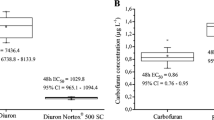Abstract
The chronic toxicity of ethyl parathion and isobutoxyethanol ester of 2,4-dichlorophenoxyacetic acid was determined for the crabs Uca uruguayensis and Chasmagnathus granulata collected in Argentina in 1989.
Parathion toxicity was more time-dependent than 2,4-D. Four-week LC50 values for parathion were size and species independent, as expected under chronic exposure conditions. As shown in previous studies, the opposite was noted when crabs were exposed to acute exposure. Parathion was much more toxic than 2,4-D, in all cases. Also, parathion exerted a very much lower chronic lethal effect than other pesticides at a fraction of the respective acute LC50. A different susceptibility between sexes was found in C. granulata exposed to 2,4-D.
Similar content being viewed by others
References
American Public Health Association, American Water Works Association, Water Pollution Control Federation (1976) Standards methods for the examination of water and wastewater, 14th ed, Am Public Health Assoc, Washington, DC
Anderson RL, de Foe DL (1980) Toxicity and bioaccumulation of endrin and methoxychlor in aquatic invertebrates and fish. Environ Pollut 22A:111–121
Banas WP, Sprague JB (1986) Absence of acclimation to parathion by rainbow trout during sublethal exposure. Water Res 20:1229–1232
Bliss CI (1967) Statistic in Biology. McGraw-Hill, NY
Comisión Administradora del Río de la Plata (1989) Estudio para la evaluación de la contaminación en el Río de la Plata. Informe de avance. ISBN N° 950-99583-0-1, Buenos Aires
Emery RM (1970) The comparative acute toxicity of cresol to two benthic crustaceans. Water Res 4:485–491
Finney DJ (1971) Probit analysis, 3rd ed. Cambridge University Press, London
Granmo A, Larsstuvold M (1976) Evaluation of results from short-term tests. The LC50 value and its confidence limits. In: FAO/SIDA Training Course on Aquatic Pollution in Relation to Protection of Living Resources. Rome, TF-INT 173 (SWE)-Suppl. 1, pp 232–237
Kuhnemann O (1977) Observaciones sobre la contaminación en el Estuario del Plata y su futuro en relación con el Mar Argentino adyacente. Contribución Ténica del Cibima 29:7–22
Lenardon A, Maitre de Hevia MI, Fuse J (1987) Pesticidas organoclorados y organofosforados en el Río Paraná (Argentina). II. Ciencia y Tecnologia del Auga 1:14–20
McEwen FL, Stephenson GR (1979) The use and significance of pesticides in the environment. John Wiley & Sons, NY
Molero AM, Pisanó A (1986) Different susceptibility to lindane between male and female of Cnesterodon decemaculatus. Comunicaciones Biológicas 4:377–386
Monserrat JM, Rodríguez EM, Lombardo, RJ (1991) Effects of salinity on the toxicity of parathion to the estuarine crab Chasmagnathus granulata (Decapoda, Grapsidae). Bull Environ Contam Toxicol 46:569–575
Murty A (1986) Toxicity of pesticides to fish. Vol. II. CRC Press, Boca Raton, FL
O'Brien RD (1966) Mode of action of insecticides. Ann Rev Entomol 11:369–402
Palawski D, Buckler DR, Mayer FL (1983) Survival and condition of rainbow trout (Salmo gairdneri) after acute exposures to methyl parathion, triphenyl phosphate, and DEF. Bull Environ Contam Toxicol 30:614–620
Pickering QH, Henderson C, Lemke AE (1962) The toxicity of organic phosphorus insecticides to different species of warmwater fishes. Trans Am Fish Soc 91:175–189
Rodríguez EM, Lombardo RJ (1991) Acute toxicity of parathion and 2,4-D to estuarine adult crabs. Bull Environ Contam Toxicol 46:576–582
Rodríguez EM, Amín OA (1991) Acute toxicity of parathion to larval and juvenile stages of Chasmagnathus granulata (Decapoda, Brachyura). Bull Environ Contam Toxicol 47
Stewart NE, Milemann RE, Breese WP (1967) Acute toxicity of the insecticide Sevin® and its hydrolytic product 1-naphthol to some marine organisms. Trans Am Fish Soc 96:25–30
Vernberg FJ, Vernberg W (1972) The synergistic effects of temperature, salinity and mercury on survival and metabolism of the adult fiddler crab Uca pugilator. Fish Bull 70:415–420
Vernberg FJ, Guram MS, Savory A (1977) Survival of larval and adult fiddler crabs exposed to Aroclors® 1016 and 1254 at different temperature-salinity combinations. In: Vernberg FJ (ed) Physiological responses of marine biota to pollutants. Academic Press, NY, pp 37–50
Winer BJ (1971) Statistical principles in experimental design, 2nd ed. McGraw-Hill, NY
Author information
Authors and Affiliations
Rights and permissions
About this article
Cite this article
Rodríguez, E.M., Monserrat, J.M. & Amín, O.A. Chronic toxicity of ethyl parathion and isobutoxyethanol ester of 2,4-dichlorophenoxyacetic acid to estuarine juvenile and adult crabs. Arch. Environ. Contam. Toxicol. 22, 140–145 (1992). https://doi.org/10.1007/BF00213313
Received:
Revised:
Issue Date:
DOI: https://doi.org/10.1007/BF00213313




